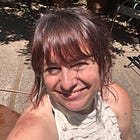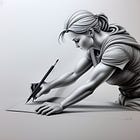From Autopilot to Authenticity: Slowing Down to Find My Voice
Or on trying again to be the writer I really am, to get my voice and brain back from the inanity of algorithmic writing

It’s been nagging at me for years that I’m not writing the way that I want to be writing. And then I am, and then I’m not …
I have been a writer for as long as I can remember. An avid journaler, a voracious reader, a go-back-to-school-again-because-I-love-learning person … a person who writes to understand herself and the world, who writes to connect with others. I’ve also been a writer for income for the past nearly two decades. I’ve written books, blogs, print and online articles, social media content, reviews, even horoscopes over the years. For many years, I wrote about many things, pretty much anything that the Internet would pay me to write so that I could afford to live in San Francisco as a writer. For many years, I wrote the kinds of things that ChatGPT can write for me now. Alongside that, I also always wrote more original things, things I was passionate about, things I believed in.
Over time, though, those things naturally collided. I hit a point where in order to pay the bills, I was churning out so much “content” that I began to think in keywords. I was writing for money, for Google, for Yoast. (One of my pet peeves is that to get a green light from Yoast, you have to use a ridiculous number of transitional words (furthermore, moreso, however, therefore …) and you have to write to an eight grade reading level … I don’t want to live in a world where all things are written this way.) I am grateful for all of the writing jobs I have been paid to do. And honestly a lot of that writing was fine in the sense that I had reached a stage of my career where at least I could pick to write about topics I cared about. I had been honing my niche for a long time in writing at the intersection of art/craft and mental health/ wellness so that even these paid gigs often allowed me to interject my expertise, my areas of interest, my passions and opinions. I was lucky that way. And yet … to even remotely pay the bills, there was just soooo much content to churn out. I began writing on autopilot. Sometimes it feels like I’ve been writing on autopilot forever, sometimes it feels like I don’t have a voice of my own.
It’s not true, though. Or it’s only partially true - a thing to be aware of when I’m writing. I started my Patreon-only blog a few years back (which I’ve now switched to here on Substack) because I wanted to start getting my voice back, my brain back, my ability to write for humans instead of algorithms back. I have consistently continued to honor that voice in private and public writing. And yet … I am still working on getting it back or getting to the next place with it or … something.
The key thing that I want to make sure to address in everything I write here … hopefully in most things I write anywhere from now on … is including my own original thoughts about the intersection of art and mental health in the piece that I am writing. It’s easy to pull together the quotes from different sources to compile the story and that’s part of the job of what I’m doing … but it’s harder to take the time to actually digest the information and slow down and share what I really think about it. What I have forgotten as a writer is less about how to write and more about how to slow down and digest and edit and add and let it all percolate before hitting publish. That’s the part I want to remember. The part that is hard to stick with because of this era we live in of publishing such a ridiculous amount of “content.” It’s the part I’m working towards.
We know things. Then we forget. Then we remember. Now I remember.
If you read this far, perhaps you liked the work. The work does take work. It only continues with support, so please consider subscribing. My annual rate starts at $10 per year.






